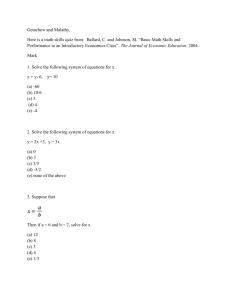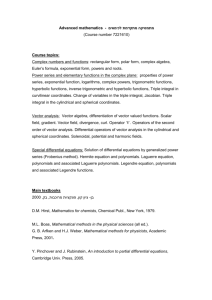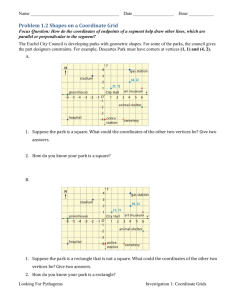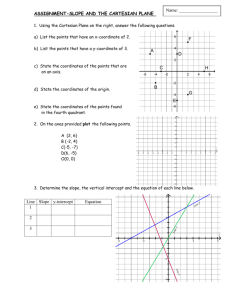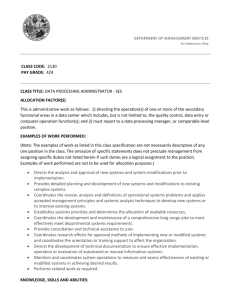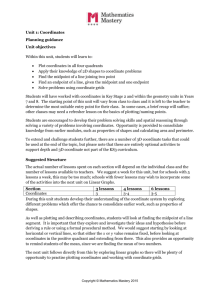14 Change of basis
advertisement
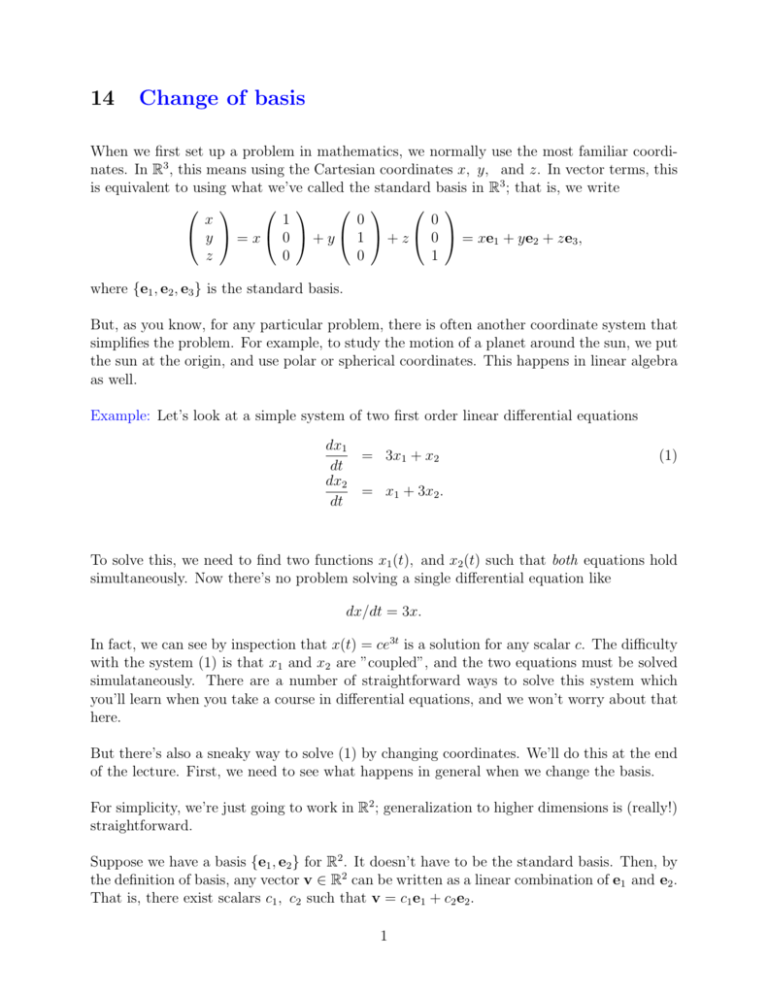
14
Change of basis
When we first set up a problem in mathematics, we normally use the most familiar coordinates. In R3 , this means using the Cartesian coordinates x, y, and z. In vector terms, this
is equivalent to using what we’ve called the standard basis in R3 ; that is, we write
x
1
0
0
y = x 0 + y 1 + z 0 = xe1 + ye2 + ze3 ,
z
0
0
1
where {e1 , e2 , e3 } is the standard basis.
But, as you know, for any particular problem, there is often another coordinate system that
simplifies the problem. For example, to study the motion of a planet around the sun, we put
the sun at the origin, and use polar or spherical coordinates. This happens in linear algebra
as well.
Example: Let’s look at a simple system of two first order linear differential equations
dx1
= 3x1 + x2
dt
dx2
= x1 + 3x2 .
dt
(1)
To solve this, we need to find two functions x1 (t), and x2 (t) such that both equations hold
simultaneously. Now there’s no problem solving a single differential equation like
dx/dt = 3x.
In fact, we can see by inspection that x(t) = ce3t is a solution for any scalar c. The difficulty
with the system (1) is that x1 and x2 are ”coupled”, and the two equations must be solved
simulataneously. There are a number of straightforward ways to solve this system which
you’ll learn when you take a course in differential equations, and we won’t worry about that
here.
But there’s also a sneaky way to solve (1) by changing coordinates. We’ll do this at the end
of the lecture. First, we need to see what happens in general when we change the basis.
For simplicity, we’re just going to work in R2 ; generalization to higher dimensions is (really!)
straightforward.
Suppose we have a basis {e1 , e2 } for R2 . It doesn’t have to be the standard basis. Then, by
the definition of basis, any vector v ∈ R2 can be written as a linear combination of e1 and e2 .
That is, there exist scalars c1 , c2 such that v = c1 e1 + c2 e2 .
1
Definition: The numbers c1 and c2 are called the coordinates of v in the basis {e1 , e2 }.
And
c1
ve =
c2
is called the coordinate vector of v in the basis {e1 , e2 }.
Theorem: The coordinates of the vector v are unique.
Proof: Suppose there are two sets of coordinates for v. That is, suppose that v = c1 e1 +c2 e2 ,
and also that v = d1 e1 + d2 e2 . Subtracting the two expressions for v gives
0 = (c1 − d1 )e1 + (c2 − d2 )e2 .
But {e1 , e2 } is linearly independent, so the coefficients in this expression must vanish: c1 −
d1 = c2 − d2 = 0. That is, c1 = d1 and c2 = d2 , and the coordinates are unique, as claimed.
Example: Let us use the basis
1
2
−2
,
,
3
3
5
{e1 , e2 } =
and suppose
v=
.
Then we can find the coordinate vector ve in this basis in the usual way, by solving a system
of linear equations. We are looking for numbers c1 and c2 (the coordinates of v in this basis)
such that
1
−2
3
c1
+ c2
=
.
2
3
5
In matrix form, this reads
Ave = v,
where
A=
1 −2
2
3
, v=
3
5
, and ve =
c1
c2
.
We solve for ve by multiplying both sides by A−1 :
−1
ve = A v = (1/7)
3 2
−2 1
3
5
= (1/7)
19
−1
=
Exercise: Find the coordinates of the vector v = (−2, 4)t in this basis.
2
19/7
−1/7
14.1
Notation
In this section, we’ll develop a compact notation for the above computation that is easy to
remember. Start with an arbitrary basis {e1 , e2 } and an arbitrary vector v. We know that
v = c1 e 1 + c2 e 2 ,
where
c1
c2
= ve
is the coordinate vector. We see that the expression for v is a linear combination of two
column vectors. And we know that such a thing can be obtained by writing down a certain
matrix product:
If we define the 2 × 2 matrix E = (e1 |e2 ) then the expression for v can be simply written as
v = E · ve .
Now suppose that {f1 , f2 } is another basis for R2 . Then the same vector v can also be
written uniquely as a linear combination of these vectors. Of course it will have different
coordinates, and a different coordinate vector vf . In matrix form, we’ll have
v = F · vf .
Exercise: Let {f1 , f2 } be given by
1
1
,
If
v=
3
5
1
−1
.
,
(same vector as above) find vf and verify that v = F · vf = E · ve .
Remark: This works just the same in Rn , where E = (e1 | · · · |en ) is n × n, and ve is n × 1.
Continuing along with our examples, since E is a basis, the vectors f1 and f2 can each be
written as linear combinations of e1 and e2 . So there exist scalars a, b, c, d such that
1
1
−2
f1 =
= a
+b
1 2
3 1
1
−2
f2 =
= c
+d
−1
2
3
We won’t worry now about the precise values of a, b, c, d, since you can easily solve for them.
3
Definition: The change of basis matrix from E to F is
a c
P =
.
b d
Note that this is the transpose of what you might think it should be; this is because we’re
doing column operations, and it’s the first column of P which takes linear combinations of
the columns of E and replaces the first column of E with the first column of F , and so on.
In matrix form, we have
F =E·P
and, of course, E = F · P −1 .
Exercise: Find a, b, c, d and the change of basis matrix from E to F .
Given the change of basis matrix, we can figure out everything else we need to know.
• Suppose v has the known coordinates ve in the basis E, and F = E · P . Then
v = E · ve = F · P −1 ve = F · vf .
Remember that the coordinate vector is unique. This means that
vf = P −1 ve .
If P changes the basis from E to F , then P −1 changes the coordinates from ve to vf 1 .
Compare this with the example at the end of the first section.
• For any nonsingular matrix P , the following holds:
v = E · ve = E · P · P −1 · ve = G · vg ,
where P is the change of basis matrix from E to G: G = E · P , and P −1 · ve = vg are
the coordinates of the vector v in this basis.
• This notation is consistent with the standard basis as well. Since
1
0
e1 =
, and e2 =
,
0
1
we have E = I2 , and v = I2 · v
Remark: When we change from the standard basis to the basis {e1 , e2 }, the corresponding matrices are I (for the standard basis) and E. So according to what’s just
been shown, the change of basis matrix will be the matrix P which satisfies
E = I · P.
In other words, the change of basis matrix in this case is just the matrix E.
Warning: Some texts use P −1 instead of P for the change of basis matrix. This is a convention, but you
need to check.
1
4
Exercises: Let E = (e1 |e2 ), and F = (f1 |f2 ), where
1 −1
2 1
E=
, and F =
.
2
1
−2 1
1. Using the technique described in the notes, find the change of basis matrix P from E
to F by expressing {f1 , f2 } as linear combinations of e1 and e2 .
2. Now that you know the correct theology, observe that F = EE −1 F , and therefore the
change of basis matrix must, in fact, be given by P = E −1 F . Compute P this way
and compare with (1)
First example, cont’d We can write the system of differential equations in matrix form as
dv
1 3
=
v = Av.
(2)
3 1
dt
We change from the standard basis to F via the matrix
1
1
F =
.
1 −1
Then, according to what we’ve just worked out, we’ll have
vf = F −1 v, and taking derivatives,
dvf
dv
= F −1 .
dt
dt
So using v = F vf and substituting into (2), we find
dvf
dvf
= AF vf , or
= F −1 AF vf .
dt
dt
Now an easy computation (do it!) shows that
4
0
−1
F AF =
,
0 −2
and in the new coordinates, we have the system
dvf1
dt
dvf2
dt
= 4vf 1
= −2vf 2
In the new coordinates, the system is now decoupled and easily solved to give
vf1 = c1 e4t
vf2 = c2 e−2t ,
5
where c1 , c2 are arbitrary constants of integration. We can now transform back to the original
(standard) basis to get the solution in the original coordinates:
v1
1
1
c1 e4t
c1 e4t + c2 e−2t
v = F vf =
=
=
.
v2
1 −1
c2 e−2t
c1 e4t − c2 e−2t
A reasonable question at this point is “How does one come up with this new basis F ? It
clearly was not chosen at random. The answer has to do with the eigenvalues and eigenvectors
of the coefficient matrix of the differential equation, namely the matrix
1 3
A=
.
3 1
All of which brings us to the subject of the next lecture.
6

